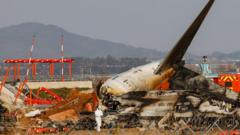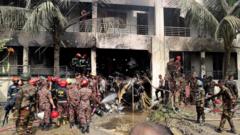The investigation into the Air India Flight 171 crash in Ahmedabad is underway as experts analyze wreckage and data recorders to uncover the causes of this rare aviation disaster, while also preparing for the potential implications for aviation safety regulations.**
Investigating the Air India Boeing 787 Crash: A Complex Task Ahead**

Investigating the Air India Boeing 787 Crash: A Complex Task Ahead**
Aviation experts begin a thorough investigation into the Air India Flight 171 disaster, exploring multiple possible causes for the crash that took place shortly after takeoff.**
The tragic crash of Air India Flight 171 shortly after its departure from Ahmedabad last week has led to a significant aviation investigation. Within just 40 seconds of takeoff, the Boeing 787 Dreamliner, carrying 242 passengers and nearly 100 tonnes of fuel, descended rapidly into a populated area, leading to a catastrophic event marked by flames and destruction.
Investigators are now tasked with the detailed examination of the wreckage while simultaneously working to decode data from the aircraft's cockpit voice and flight data recorders, commonly known as black boxes. In adherence to international regulatory frameworks established by the UN aviation authority ICAO, a preliminary report of findings is expected within 30 days, while a comprehensive final report may take up to a year.
Captain Sumeet Sabharwal and co-pilot Clive Kundar piloted the ill-fated flight, which had just taken off at 13:39 local time (08:09 GMT) before a distress call was made from the cockpit moments later. No further transmissions were recorded before the aircraft crashed.
The circumstances surrounding the crash are rare, noted Captain Kishore Chinta, a former investigator for India's Aircraft Accident Investigation Bureau (AAIB), describing it as a "controlled flight into terrain." A range of potential factors are under investigation, including whether mechanical failures, bird strikes, or pilot error contributed to the crash.
The first critical insights into the incident may emerge from the wreckage of the two engines, which can indicate whether they were operational at the time of impact. Investigators will analyze the particular damage patterns to draw conclusions about engine performance preceding the crash. If the engines were found to be inoperable, the inquiry would likely shift its focus to the cockpit.
The Enhanced Airborne Flight Recorders onboard are pivotal in revealing the events leading up to the crash. Such devices capture extensive data, from cockpit conversations to key operational metrics like thrust settings and fuel flow. As investigators recover and analyze this critical information, attention will turn toward aspects like flaps and slats—elements crucial for lift during takeoff.
Should the investigation point to a failure in the flight management control system, it would create significant concerns not only for Boeing but globally across the aviation sector. Investigators are expected to work meticulously, examining each piece of wreckage for clues, including parts of the engines, systems, and even pilot training records.
The wreckage itself is invaluable data, as previous investigations have shown the importance of examining every detail, from wiring to mechanical components. While the current focus remains on this event, experts suggest the advanced technology involved in modern aircraft may enhance the investigation's efficiency compared to earlier, less sophisticated systems.
Indian civil aviation authorities have reported that their inspections did not reveal major safety issues within Air India's Boeing 787 fleet prior to the accident. Boeing, while cooperating with the investigation led by the AAIB, has no initial signs of fault on its aircraft.
As investigators delve deeply into the various technical and operational factors surrounding this aviation catastrophe, the complexities involved reiterate the ongoing challenges aircraft safety presents. While early indicators could emerge relatively quickly, the full understanding of causality and preventative measures will require longer, thorough analysis in the months to come.





















